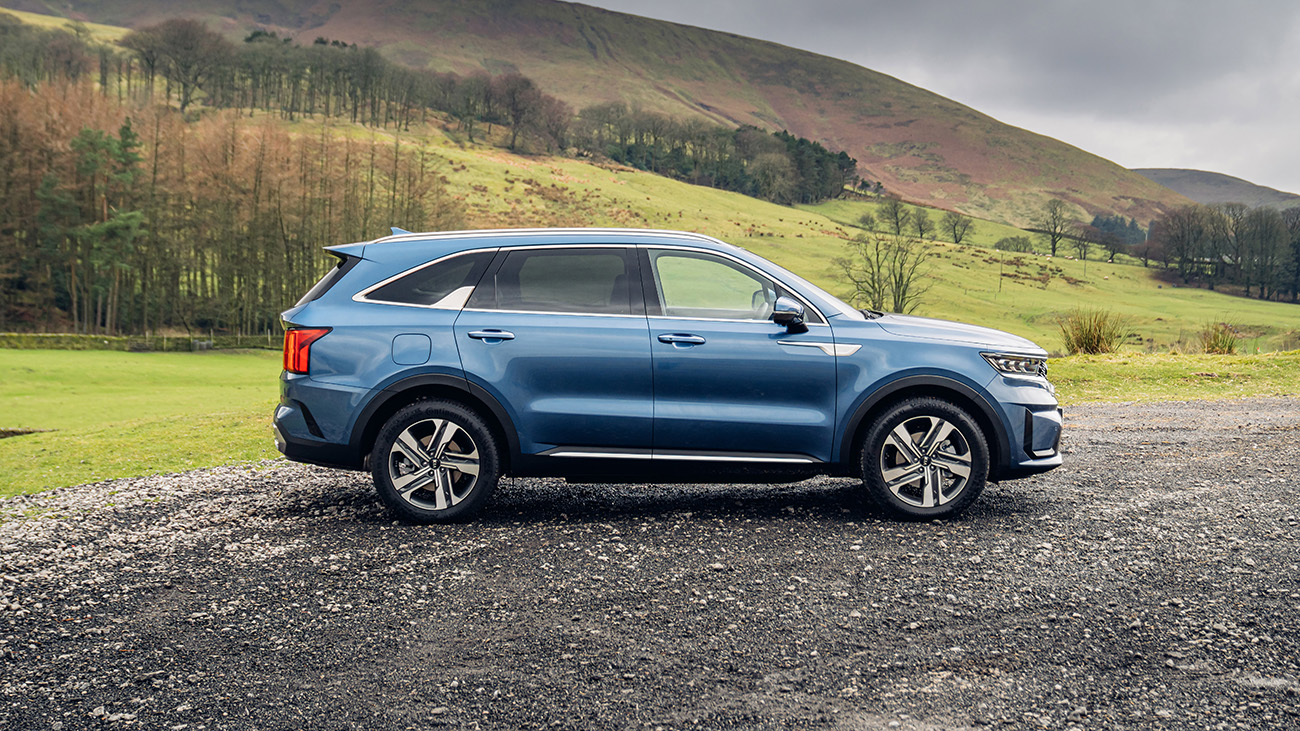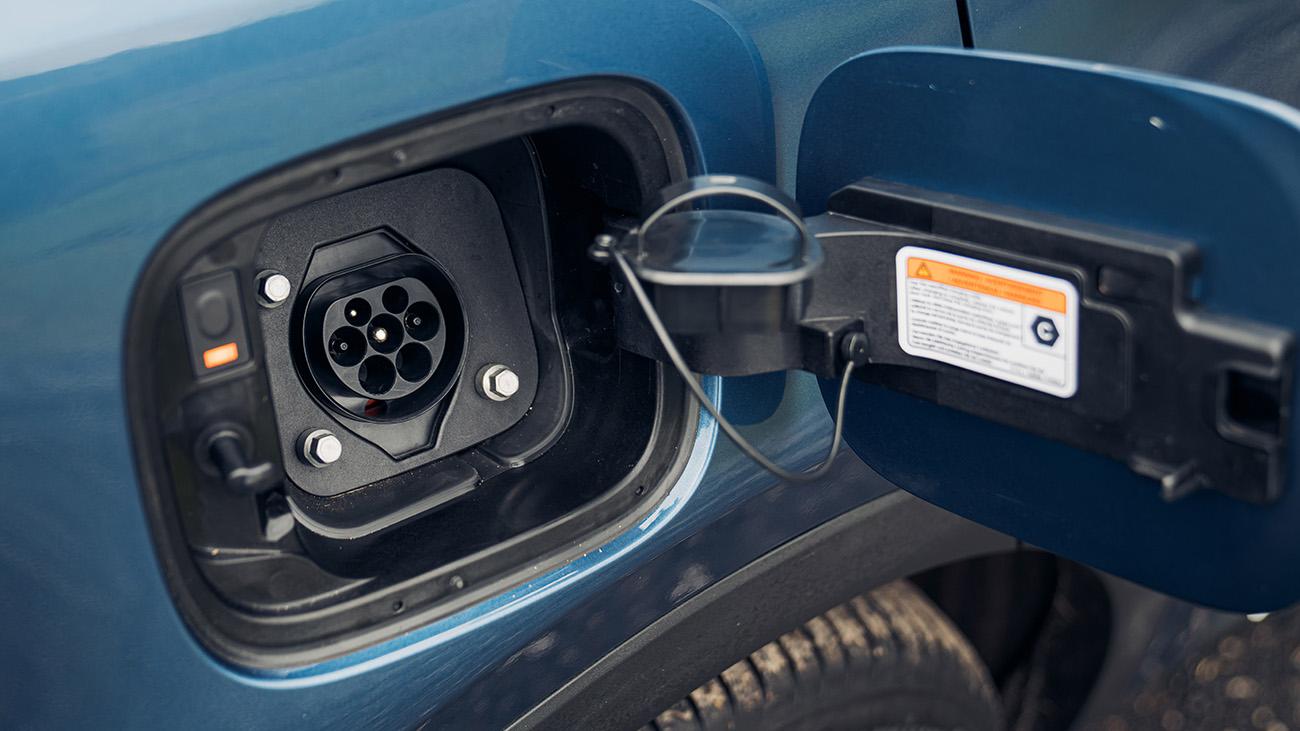
SPEC HIGHLIGHTS
- Battery
Capacity13.8kWh
- BHP
261bhp
- 0-62
8.4s
- Max Speed
119Mph
Ah, fresh from blocking the Suez Canal…
No, this isn’t the Ever Given, it’s the new seven-seater Kia Sorento in plug-in guise. More of a barge than a container ship. We drove the top-spec ‘4’ model, all eye-watering £53k of it. Remember when Kias were tiny, cost pennies and were made of cardboard? It wasn’t all that long ago, in geological terms.
Does it actually seat seven?
This new fourth-generation Sorento has an extra 35mm in the wheelbase, is slightly wider and taller and gains a smidgen overall length with a 10mm increase. The big news is that Kia has managed to shove the battery pack in underneath the cabin floor without stealing valuable luggage and passenger space like others do. In fact, most other seven-seat IC cars have had to ditch the extra two seats in the transition to PHEV guise, so hats off to Kia for its packaging smarts.
It’s quite roomy in the Sorento, then, particularly in the middle row, which comes equipped with extra USBs for improved driver peace and quiet. The back row has the usual caveats – strictly for children or people you don’t like back there. A 604-litre load space with five seats isn’t to be sniffed at, 1,988 with the back pews folded is positively cavernous. There’s even vestigial bootspace (175 litres) with all seven seats up, room for a petrol station sandwich, that sort of thing. Something to nibble on while you wait for the kids at lacrosse practice or whatever you’re inflicting on them this month. They’ll thank you in the end.
How far will it go on electric only?
The Sorento PHEV is rated at 35 miles of WLTP range in electric mode, 43 if you just drive in the city. Stick it in auto and the car’s clever brain will eke out the juice for maximum efficiency, bringing in the combustion engine for acceleration and higher speed running. The 14kWh battery is chargeable via a Type 2 socket and a 3.3kW onboard charger. It’s a sedate level of charging – at 3.3kW you’ll get five to six miles per hour – best suited to plugging in at home overnight.
What are the toys like?
Forgetting all the useful stuff, we had the most fun with the passenger intercom feature that takes the driver’s voice and plays it through the rear speakers. Presumably for shouting at the kids in the third row, but useful for pretending you’re flying a plane when no one else is around. The thing we missed most afterwards is the little blindspot camera view that pops up in the instrument panel when you indicate, giving you a view down the side of the car – so immediately and intuitively useful, why has no one else thought of it yet?
How does it drive?
Top Gear
Newsletter
Thank you for subscribing to our newsletter. Look out for your regular round-up of news, reviews and offers in your inbox.
Get all the latest news, reviews and exclusives, direct to your inbox.
It’s no MX-5, but let’s stop pretending that a 2.1-tonne SUV is ever going to be able to duke it out with a tiny Japanese roadster on merit. The Sorento does well to disguise its mass on the road, but there’s some lean. Ride comfort is decent, and the car’s smoothness plays into the way an electric powertrain naturally encourages you to drive in a more relaxed fashion. You’ll find yourself easing off the throttle to keep in electric mode, or coming off the gas well before a corner or junction in order to maximise the regenerative braking and saving energy. Of course, being in one of the largest cars on the road means that you feel imperious, hoisted up behind the wheel and surveying the road ahead. Five minutes on the road and you can see why people like driving these.
What about the competition?
The curious thing is that adding batteries and assorted EV paraphernalia does take up a bit of space, and the best space to steal from a car is in the boot, because it’s just sitting there doing nothing (except occasionally holding luggage). The problem then for a seven-seater is that those cars don’t really have boots when all the seats are in place, just enough room for every passenger to have a carton of juice at your next stop. Lots of traditional IC-engined seven-seaters have found themselves forced to give up the extra chairs in the transition, so immediately the likes of the Mitsubishi Outlander, Land Rover Discovery Sport and Audi Q7 (natural rivals) are ruled out of contention, while the Skoda Kodiaq, Land Rover Discovery and Peugeot 5008 don’t yet offer an electric option.
Someone must offer seven seats and zero emission capability?
So here we are – the only other PHEV with room for everyone is the Volvo XC90 Twin Engine, starting at £65,540 and moseying on up to £75,190. Suddenly spending £50,595 on a well-specced Kia doesn’t seem so bad. The Toyota Highlander is a similar price to the Sorento PHEV (it starts at £50k) but that’s just a boring normal hybrid that can only go a few hundred metres in EV mode at a time. Otherwise you’re looking at a variety of all-electric (and expensive) Teslas or the Mercedes EQV. Phew.
So should I go for the Sorento PHEV?
Plug-ins like this aren’t yet a catch-all solution, so you could save some money by looking further down the range. Let’s look at the ‘3’ spec model, which is the one available with the most options. You can get it with a PHEV, standard hybrid or diesel powertrain, setting you back £48,895, £43,010 and £41,520 respectively (or £531/£457/£413 if you’re looking at monthly leasing costs). Something for everyone. That said, it’s the scarcity of PHEV rivals that lends the Sorento bonus points, otherwise it’s a bit of a dogfight in this segment. If you’ve got easy access to a plug next to where you’ll park it and you’ll get the most out of the limited range, then fill your boots.
Score: 7/10
Featured

Trending this week
- Car Review
BMW 1 Series
- Top Gear's Top 9
Nine dreadful bits of 'homeware' made by carmakers






